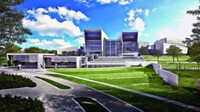Advertisement
Grab your lab coat. Let's get started
Welcome!
Welcome!
Create an account below to get 6 C&EN articles per month, receive newsletters and more - all free.
It seems this is your first time logging in online. Please enter the following information to continue.
As an ACS member you automatically get access to this site. All we need is few more details to create your reading experience.
Not you? Sign in with a different account.
Not you? Sign in with a different account.
ERROR 1
ERROR 1
ERROR 2
ERROR 2
ERROR 2
ERROR 2
ERROR 2
Password and Confirm password must match.
If you have an ACS member number, please enter it here so we can link this account to your membership. (optional)
ERROR 2
ACS values your privacy. By submitting your information, you are gaining access to C&EN and subscribing to our weekly newsletter. We use the information you provide to make your reading experience better, and we will never sell your data to third party members.
Safety
Agency Unveils New Biodefense Lab Plans
Biosecurity: Homeland Security officials say design changes have reduced risks of research on animal pathogens
by Glenn Hess
March 6, 2012

Significant modifications in the design of a proposed animal disease research laboratory in Kansas have dramatically reduced the risk of an accidental release of dangerous pathogens to nearly zero, according to the Department of Homeland Security. Nonetheless, there is no plan to begin construction of the laboratory with Congress and the White House at loggerheads over paying for it.
In a risk assessment issued on March 2, DHS estimates that the probability is now only 0.11% that a highly contagious animal pathogen, such as foot-and-mouth disease, could escape sometime during the projected 50-year lifespan of the proposed facility, even in the event of a catastrophic earthquake or tornado.
In 2010, a National Research Council study on the feasibility of locating the lab in the nation’s heartland found “several major shortcomings” in the lab’s original design. NRC determined that there was a 70% chance that an accidental release would occur and infect livestock, which it estimated could cause up to $50 million in economic damage.
Those findings prompted DHS to make changes in the facility’s design, and Congress subsequently directed the department to conduct a new risk analysis.
The laboratory—the National Bio & Agro-Defense Facility (NBAF)—will study foreign animal diseases at a site adjacent to Kansas State University, in Manhattan, Kan. The facility, estimated to cost up to $1 billion, is intended to replace the outdated Plum Island Animal Disease Center near Long Island, N.Y.
The revised NBAF design “is sound and incorporates best practices used in other animal and zoonotic pathogen laboratory facilities that safely operate throughout the country,” says Tara O’Toole, head of the DHS Science & Technology Directorate. “This detailed, updated risk assessment reaffirms that we can build a safe and secure facility to meet this important mission.”
DHS’s analysis will now be reviewed by NRC, which is expected to report its findings to Congress this summer.
Last year, President Barack Obama asked Congress to provide $150 million for the project, but lawmakers approved only $50 million—not enough to begin construction. Obama’s fiscal 2013 budget proposal, released last month, does not seek any additional money for lab construction.
On Feb. 15, Homeland Security Secretary Janet Napolitano told the House Committee on Homeland Security that because of budget constraints, the Administration is taking a step back to review the scope and cost of the project. But she predicted that NBAF will be built.
The project is strongly supported by Kansas politicians. “Without NBAF, our country remains at risk from foreign animal disease outbreaks,” says Sen. Pat Roberts (R-Kan.). “It is critical that construction of NBAF begins immediately to safeguard against these threats and the devastation they would cause.” The DHS assessment, he adds, “should help allay concerns from any opposition, in the public or Congress.”
However, Rep. Timothy H. Bishop (D-N.Y.) has been fighting to keep open the existing lab on Plum Island, which is in his congressional district. He argues that NBAF would duplicate the research functions of other facilities across the country including the Plum Island research center.





Join the conversation
Contact the reporter
Submit a Letter to the Editor for publication
Engage with us on Twitter